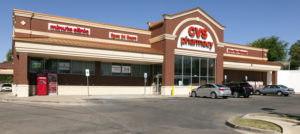By David Thill
Partnerships with health systems may prove beneficial for both providers
Editor’s note: Traditionally, patients had two options for seeking healthcare: the doctor’s office or the hospital. However, advances in medical research, technology, and team-based care – and the developing shift to value-based care – have left patients with a host of options for obtaining the treatment they need. In this continuing series, we examine ongoing changes in health systems, and how they affect patients, doctors, and, of course, Repertoire’s readers.
 Retail clinics – which include in-store care centers such as CVS MinuteClinic, Walgreens Healthcare Clinic, and Walmart Care Clinic – first appeared in 2000, treating basic ailments: strep throat, colds, ear infections, etc. The industry grew rapidly but then slowed down.
Retail clinics – which include in-store care centers such as CVS MinuteClinic, Walgreens Healthcare Clinic, and Walmart Care Clinic – first appeared in 2000, treating basic ailments: strep throat, colds, ear infections, etc. The industry grew rapidly but then slowed down.
In the last year, however, “there has been renewed interest in operating retail clinics by health systems,” states a June 2016 report by the consulting firm Merchant Medicine. These partnerships, including one announced in January 2016 between Advocate Health Care and the 56 Walgreens Healthcare Clinics throughout greater Chicagoland, forge alliances between would-be competitors, and may help lead to the future success of both healthcare providers.
The health system-retail clinic partnership
 “The Advocate/Walgreens model is a successful model…which benefits the patient, health system and clinic organization alike,” Tine Hansen-Turton, MGA, JD, wrote in an email to Repertoire. Hansen-Turton is the executive director of the Convenient Care Association, the national trade association for retail clinics.
“The Advocate/Walgreens model is a successful model…which benefits the patient, health system and clinic organization alike,” Tine Hansen-Turton, MGA, JD, wrote in an email to Repertoire. Hansen-Turton is the executive director of the Convenient Care Association, the national trade association for retail clinics.
In addition to expanding health systems’ influence in communities that are outside their primary service areas, “[t]hese partnerships provide a linkage to care to the more than 50-60 [percent] of retail clinic patients who do not have a primary care provider,” she says.
A 2016 report released by the Convenient Care Association on partnerships between health systems and retail clinics cites research indicating that “retail clinics are the lowest cost unsubsidized provider of healthcare” in the country. Additionally, the report says that almost 40 percent of the urban U.S. population lives within 10 minutes of a retail clinic, making it a convenient option. Recently, retail clinics have also expanded service beyond basic ailments, including chronic care management.
The Convenient Care Association believes that given these factors, partnerships between retail clinics and health systems are advantageous to all parties because they offer:
- Expanded access to affordable healthcare through retail clinics.
- The ability of those clinics to meet patient needs by treating basic acute care for minor illness and injuries, as well as chronic conditions such as diabetes and hypertension.
- The ability of retail clinics to work with health networks to provide high-quality care for patients.
- Greater continuity and coordination of care for patients.
“Retail clinics are an integral part of the healthcare ecosystem, not a separate network,” the report concludes, “and the growing number of partnerships with hospitals and health systems indicates [retail clinics’] increasingly important role in the healthcare continuum.”
Skepticism in the physician community
Retail clinics have not always been a welcome member of the broader healthcare community. As recently as 2014, for example, the American Academy of Pediatrics (AAP) opposed retail clinics “as a source of primary care for pediatric patients, because they risk increasing care that is fragmented and detrimental to the medical home concept of longitudinal and coordinated care.” However, the organization did set guidelines at that time for how retail clinics and primary care physicians can partner to provide optimal healthcare for patients.
“We recognize that retail clinics have been around for awhile,” says Michael Munger, M.D., a family physician at Saint Luke’s South Primary Care in Overland Park, Kan., and president-elect of the board of the American Academy of Family Physicians (AAFP). He acknowledges retail clinics as “part of the medical neighborhood,” but stresses that they raise concerns about fragmentation of care.
The AAFP’s official policy states, in part, that while “retail clinics may provide a limited scope of health care services for patients, this can ultimately lead to fragmentation of the patient’s health care unless it is coordinated with the patient’s primary care physician’s office.”
Additionally, the AAFP “opposes the expansion of the scope of services of retail clinics beyond minor acute illnesses and, in particular, opposes the management of chronic medical conditions in this setting. Protocol-based decision and diagnostic models are used in most non-physician led retail clinics, resulting in a missed opportunity to address more complex patient needs.”
Retail clinics tend to be staffed by nurse practitioners and PAs, formerly known as physician assistants. A 2015 report from the Convenient Care Association, however, makes the case that “there is no evidence that requiring an on-site presence by collaborating physicians or restricting the number of practitioners or [convenient care centers] they can supervise produces higher quality care than remote supervision with regular chart review.”
Munger and his colleagues believe that when patients seek treatment at retail clinics, they risk not being treated for underlying issues. As he puts it, when he sees a patient, “I don’t just look for the sniffle; I look for the chance to see the patient as the entire person.”
He does note that positive developments have been made in the industry to increase communication between clinic and physician. For example, when patients identify their primary care physicians to retail clinics, those clinics sometimes forward information from the visit back to the physician. Additionally, some retail clinics offer contacts for potential primary care physicians to patients who do not already have them.
Meeting patient needs
“I think the important message is, patients need care outside of nine to five, Monday through Friday,” explains Munger. If the primary care physician model is going to stay patient-centered, he says, it needs to change. And many of those changes are already taking place, thanks to the push from the retail clinic industry. “It’s encouraged family physicians to look to the needs of their patients” and accommodate them.
For example, most family physicians have begun offering same-day appointments and extended hours, Munger says. His own clinic has a phone line staffed 24 hours a day, which patients can call when they experience health issues, and receive a physician response in less than 20 minutes. If the issue can wait, the patient can schedule an appointment, and if not, the office will direct them to visit a retail clinic.
“I think the key is that patients should always reach out to their primary care physicians first,” says Munger.
Moving forward
Hansen-Turton says that retail clinics have partnered with over 100 health systems and physician groups throughout the country, helping those health systems grow. “I would go as far as [to] say that health systems won’t be successful in meeting [their consumers’ needs] without an accessible, quality retail clinic…partner in the community.”
Munger acknowledges that retail clinics “are here, and here to stay.” But he still asserts that healthcare providers need to keep the whole patient in view – not just their symptoms.
Regarding partnerships between health systems and retail clinics, such as the one between Advocate and Walgreens, “I think such partnerships in general will help foster better communication throughout the entire [healthcare] system,” says Munger. He believes that by allowing for smoother coordination between the two care providers, the model “has a chance…to be beneficial for all parties.”